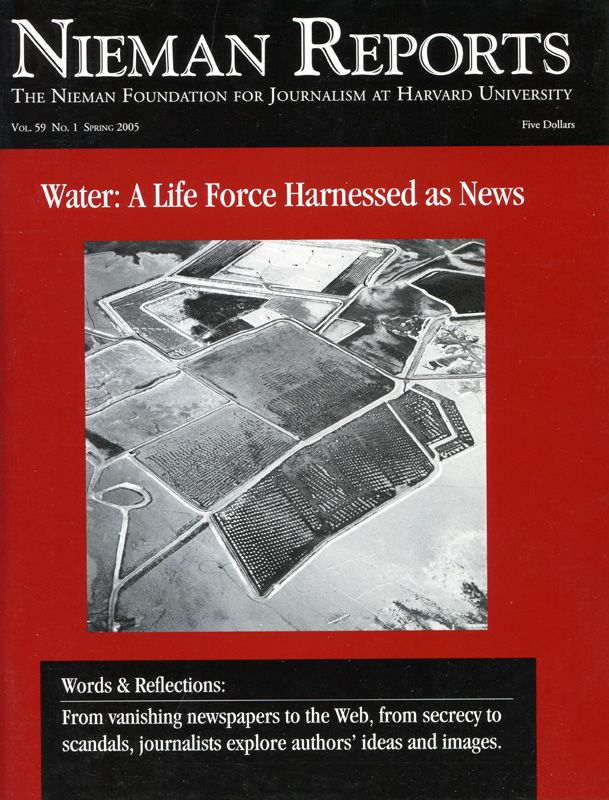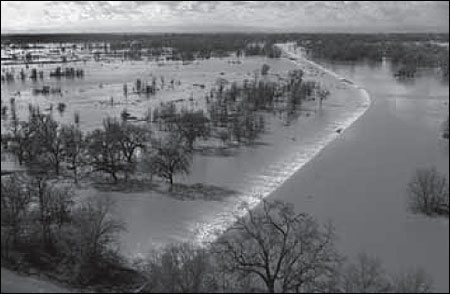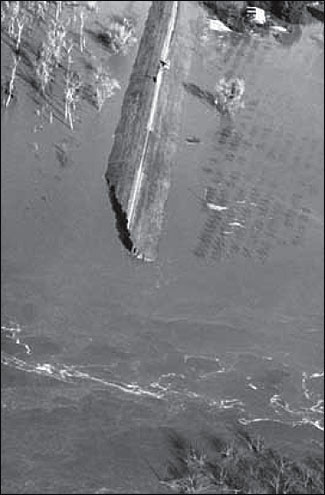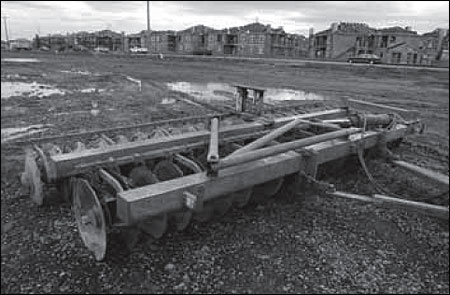
Water: A Life Force Harnessed as News
Water is the essence of life, and its cleanliness, availability, and our use and abuse of it are stories meriting reporters’ and editors’ attention. Yet as Stuart Leavenworth, who covered water issues for The Sacramento Bee and describes the wide array of issues he took on, reports: “To my chagrin, I had the beat largely to myself for four years. Across the country, papers have tackled problems of water pollution and degradation, but have overlooked fundamental issues of supply—and sustainability. This is curious.”

“Cadillac Desert” is arguably the most influential environmental book published in the past 30 years. Before Marc Reisner produced this 513- page work, there was little public understanding of the West’s powerful water rustlers; the immense public subsidies that benefited irrigated agriculture, and the myth that cities such as Phoenix, Las Vegas, and Los Angeles could continue to add millions of people without the taps running dry.
Given that “Cadillac Desert” is still a big seller, one might think that editors and broadcast producers would recognize the public’s intense interest in water issues. They don’t. With few exceptions, leading newspapers aren’t helping answer basic questions about the security of their community’s water systems, the growing privatization of water, and the inevitable impact of coming droughts and floods.
I recently finished a stint covering Western water issues for The Sacramento Bee. To my chagrin, I had the beat largely to myself for four years. Across the country, papers have tackled problems of water pollution and degradation, but have overlooked fundamental issues of supply—and sustainability. This is curious. Water makes up 70 percent of the earth’s surface and about 60 percent of our bodies’ weight. It’s a fundamental resource for life.
Reisner wrote that water flows uphill toward money. We care about money, don’t we? Business desks have reporters covering banks and oil supplies. Why not water?
The Water Beat
Media outlets only tend to focus on water when its absence or abundance creates a full-blown crisis, says Rita Schmidt Sudman, who runs the Water Education Foundation, a nonprofit based in California. Back when California Governor Jerry Brown was pushing the idea of a 42-mile Peripheral Canal to ship water from Northern to Southern California, political reporters dropped what they were doing and became experts on H2O. Voters defeated the canal in 1982, so water was ignored for a while. Interest by journalists perked up during the drought of 1987-1992, then went back into hibernation.
“Right now, I don’t see the intensity of coverage I would expect to see,” says Sudman, who notes the Colorado River is in the sixth year of drought. Las Vegas, almost wholly dependent on shrinking Lake Mead, could see its neon economy start to blink; Mexico is fighting with the United States over two rivers (the Colorado and the Rio Grande); dams might be torn down in the Northwest to help salmon.
“Water is all about power politics,” says Sudman, who has covered these stories for more than 25 years for Western Water, a quarterly publication. “It involves money and growth and where people will live and how they will live. It’s a great story, and it deserves to be taken seriously.”
Here are some prevailing myths about the water beat:
- Water is boring: Tell this to anyone who has seen the movie “Chinatown.” The exercise of brute waterpower is a fascinating tale and, although today’s water barons don’t usually slice open each other’s noses, they still play tough.
- Water is an environment beat: Partly, yes, but not entirely. Covering water involves a fundamental understanding of engineering, economics, meteorology and agriculture, which is the largest user of water in the country.
- Water supply is just a West Coast worry: There is an old saying about water: On the East Coast, people take it for granted. On the West Coast, we take it from each other. The drought of 2003 revealed that hundreds of East Coast communities were unprepared to deal with even a two-month dry spell. Soon these communities were fighting among themselves for water, just like the thugs did in “Chinatown.”
I fell into the water beat like a toddler learning to swim. Before joining The Sacramento Bee, I worked as the environment reporter at The News & Observer in Raleigh, North Carolina, covering industrial hog farming, hurricanes, floods and other disasters. In North Carolina, the problem was always too much water, not too little. Few people in the Tar Heel state had ever heard of the U.S. Bureau of Reclamation.
When I arrived at the Bee, the newspaper already had a water reporter— Nancy Vogel, a tenacious, energetic journalist whose talents weren’t fully appreciated at the paper. When the Los Angeles Times snapped Nancy away, the water beat went unfilled for many months. In 2001, I jumped into the void, at a time when California’s water world was undergoing a historic transition.
For decades, agriculture in California has consumed the bulk of the state’s developed water. Cities consumed less than 15 percent. But the cities and suburbs are growing, adding 500,000 people a year. Given that Congress is no longer subsidizing the construction of new water supply reservoirs, water is certain to be reallocated in California. The question will be how this happens.
Along with business reporter Dale Kasler, I started to examine the brave new world of water trading in California. That’s right. Water, a public resource, is being bought and sold like pork bellies. In the most basic of such transactions, farmers agree to idle some of their fields and sell the unused water to cities or other farm districts downstream. Southern California and the San Joaquin Valley have benefited from these transactions. So have rice farmers in Northern California, who sometimes see more profit in selling water than growing rice.
We wanted to examine the implications of this practice. We pitched a project proposal, but it didn’t get very far. With the support of a pair of editors, we decided to pursue what later was called a “stealth series.” We looked at what could happen to rural farm economies as water is sold. We profiled British financier Keith Brackpool, who had designs of getting rich off Southern California’s water needs. We examined basic questions that arise when this public resource is treated as a private commodity. There were a lot of other angles that we explored in our reporting, including emerging scientific evidence that the West had previously undergone droughts lasting 100 years or more, not just six or seven. We also examined the prospects of desalination, utilizing California’s last untapped reservoir—the Pacific Ocean—to satisfy the state’s thirst.
Much to our surprise, our stealth series ended up winning a slew of national and state prizes, including the National Press Foundation’s Thomas L. Stokes Award. That helped to elevate the stature of the beat and laid the groundwork for more coverage.
In 2003, California water managers were becoming increasingly nervous about the fast-shrinking Colorado River, which provides nearly half of Southern California’s supply and much of the water in Las Vegas, Phoenix and other cities. I knew there was a big story there. Continued drought would undoubtedly lead Southern California to look north toward the Sacramento River for water, but I needed a stronger hook. I needed something visual.
See the photo at top of the article, "By Its Absence Water Becomes a Big Story" » Around that time, one of our newspaper’s veteran photographers, Jay Mather, alerted me to Lake Powell. The giant reservoir on the Utah-Arizona border, named after explorer John Wesley Powell, had nearly dropped its level by half in three years. Houseboats were becoming stuck in the mud. Scenic canyons, long underwater, were reemerging. Water districts and utilities were contemplating what would happen if Lake Powell dropped so low it could no longer generate hydropower or deliver its required water to Arizona, Nevada and California.
No paper in California had written about Lake Powell’s demise at that point. So Jay and I traveled to Page, Utah, and spent four days exploring canyons, talking to locals, and gauging the confidence of federal water officials. Without visiting such a place, it is impossible to imagine or convey the scope of this drought. As I later wrote:
Normally holding 7.8 trillion gallons of water and stretching 180 miles into two states, Lake Powell is dropping a foot a week, slowly exposing the sinuous canyons that federal engineers flooded when they built Glen Canyon Dam in the early 1960’s. If the dry spell continues, officials of the U.S. Bureau of Reclamation will have to prepare for the unthinkable. Eventually, they say, the lake could drop so low it will stop feeding the hydroelectric penstocks that generate $70 million in power yearly for 1.7 million people throughout the Southwest. At that point, the water supply of 25 million people in California, Nevada and Arizona would also be in jeopardy. Now, one year later, Lake Powell is 60 percent empty; boat ramps are closed, and water officials are no longer describing my 2003 article as alarmist. Luckily for them, The Washington Post, Los Angeles Times, CBS News, and other outlets have started covering the Colorado River drought. Sometimes this kind of media rain dance can change the weather.

Finding Water Stories
Every good reporter is always asking the question, “What is the most important story in my own backyard?” Those who cover the water beat are no different. In Sacramento, flooding is the 800-pound gorilla. The city sits at the confluence of two powerful rivers—this was why early settlers called the Sacramento Valley the great “inland sea,” and Indian tribes never built permanent settlements in this area, knowing they would have to evacuate.
Since 1997, when floods killed six people in the Central Valley and drove 120,000 people from their homes, the Bee has covered the twists and turns of city and regional debates about upgrading levee systems. But when the water has receded, usually public interest has, too. As John Steinbeck wrote about his home state, “It never failed that during the dry years the people forgot about the rich years, and during the wet years they lost all memory of the dry years.”
As the state of California sunk deeper into its financial hole, funding for levee repairs also dwindled. I’d heard about this for months and then, in one of those moments every reporter hopes for, a source leaked to me an internal state report that laid out the scope of the cuts. In four years, the state had cut funding for flood management by 74 percent. As a consequence, levees were going unrepaired and emergency crews were unavailable to respond.
I filed a story on this report. This news just barely managed to make the front page on a strong news day. So I pitched a projects proposal, envisioning a series that would examine flood protection from a number of angles. We’d chronicle the state’s neglect of levees and the mounting liabilities that resulted. We’d focus attention on the role local governments were playing in allowing development to occur in deep flood plains. We’d turn a spotlight on our urban area and the ability of a traffic-clogged region to evacuate in the next flood emergency.
Once the editors gave the green light, we had a small window in which to report these stories. It was November, and in the Central Valley flood season ends in March. Our report needed to be published while the rivers were still high—before the Central Valley had transitioned to its eight months of bone-dry weather. This meant we had to hustle.
At the end of March 2004, our series, “Rising Risk,” examined Sacramento’s wishful reliance on 100-year-old structures— levees—that are basically piles of sand mounded up on the sides of shifting rivers. The second-day story showed how recent development in Natomas, a low-lying, fast-growing suburb north of Sacramento, could flood 20-feet deep if a levee ever broke. On the third day, graphics and a narrative story combined to show what would happen, hour by hour, if a levee broke in a downtown neighborhood and spread water throughout the city.
The day after the final story appeared, the U.S. Army Corps of Engineers and federal environmental agencies announced new policies for speeding up repair of valley levees and cited our stories as the reason. Three months later, a levee broke open west of Stockton, flooding 12,000 acres of farmland. No one was injured, but the surprise June flood revealed the vulnerability of the flood system. So far, the consequences of that single levee break have cost the state $90 million. If multiple levees broke in the Sacramento-San Joaquin Delta, it would shut down the delta’s state and federal water pumps, which supply water to 22 million people.

Stories To Be Told
During my last two years as water reporter, I sensed a fresh appreciation of the beat at the Bee. Editors started to realize water stories could be compelling and free of jargon. Most of what I wrote ended up on the front page. To be sure, I still was pulled off the beat to cover forest fires, legislative battles, and other news. Yet in an era of shrinking news holes and quick-hit coverage, the Bee had dedicated itself to water coverage. Whether that will continue is hard to predict. In December, I accepted a position as an associate editor and columnist on the Bee’s editorial pages. As this article went to press in February, the water job was still unfilled. Editors here say the newsroom will continue to cover water, but they may not do it with a single specialist. Although a tag-team approach may produce stellar coverage, that hasn’t been the case at others papers. Usually it takes a dedicated and creative water wonk to push these stories above the fold.
There is still more to tap from this beat and not just in the West. In Southeast Asia, several countries are laying the groundwork for an international water war as they build dams on the Mekong and other rivers, with little regard for their neighbors downstream. Companies based in France and Germany are buying up water utilities worldwide, creating fears that water will increasingly become a private commodity. Meanwhile, scientists agree that global warming will bring more precipitation in the form of rain instead of snow, adding to complications of water planning and flood control.
Marc Reisner passed away five years ago. Where is the next generation of water writers?
Stuart Leavenworth, an associate editor at The Sacramento Bee, has worked at daily newspapers for 20 years in California, North Carolina, Georgia, Louisiana and Tokyo, Japan.


